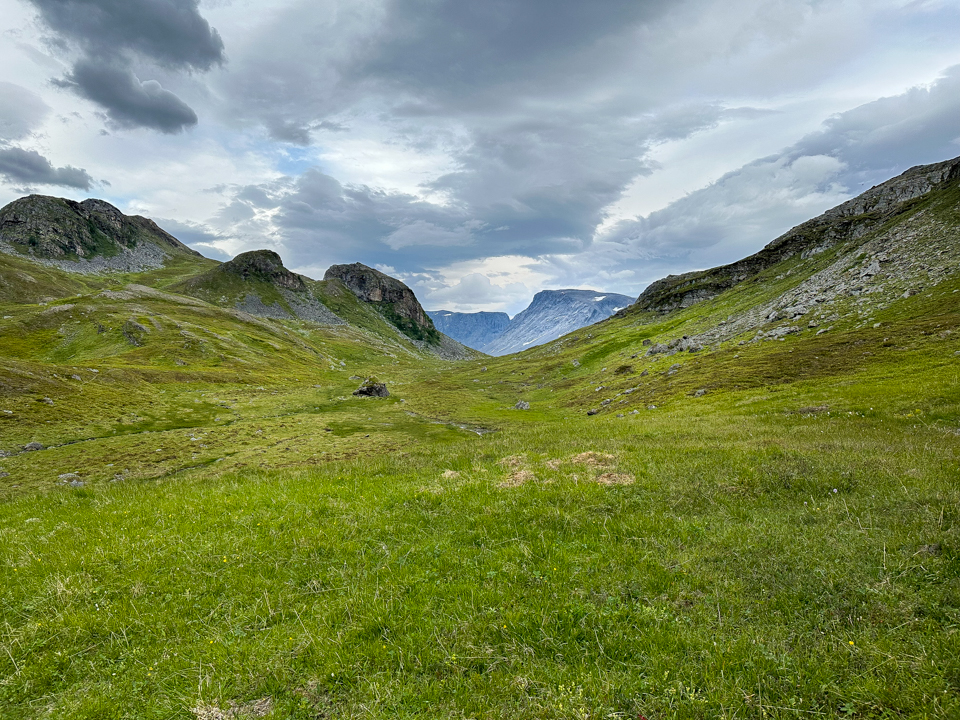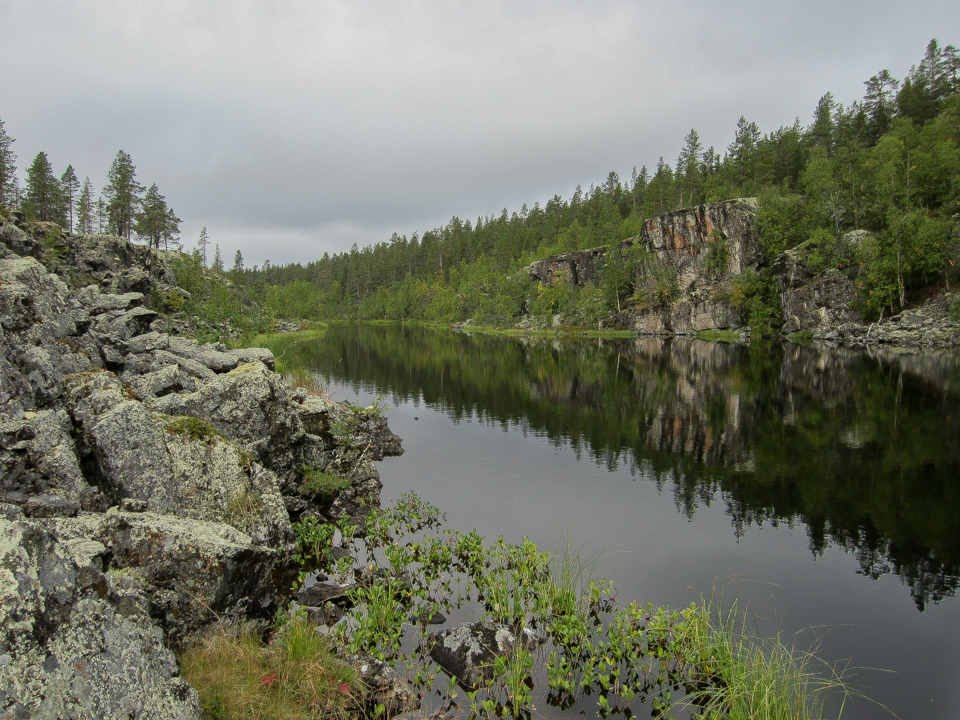2.2 Echoes at Sacred Rocks
Hard, compact rock formations are generally highly reflective, capable of generating echoes and other acoustic phenomena. This is especially true for boulders, cliffs, and mountain slopes with large, smooth vertical surfaces (Fig. 1). A look at dictionary entries shows that cliffs and echoes were closely connected to each other, at least in the traditions of the Northern and Eastern (Skolt) Sámi. The word for cliff (bákti, pä’htt) is included in expressions referring to echo (báktegájanas, pȧꭓ`t-paìjâłâs) and in phrases such as: “Are you a cliff, since you say back!” (Itkonen 1958: 330, 561, Mienna 2023).[3]
Figure 1. Mountain landscape with cliffs in Romsa, Norway, evoking echoes. Photo by authors.
Stories describing the close connection between sacred sites and echoes are known in the traditions of several Sámi groups. Although these stories were recorded in different languages, their expressions appear to refer quite unambiguously to reflections. In Njauddâm, the Skolt Sámi area, Áhkobákti (Old Woman’s Cliff) was a place where an “old noaidi” always caught wild reindeer, leaving the reindeer’s antlers for the cliff as thanks for the help. After his[4] death, his son went to Áhkobákti to see if there were reindeer for him too:
Then he went to Áhkobákti. There he found them – wild reindeer were there. He crept very close to them. Then he shot. One fell to the ground. But the wild reindeer did not run away. He thought: the wild reindeer did not run – maybe the cliff gave an echo![5] Then he shot a second time. Still, the wild reindeer did not run farther away. Then he thought the cliff gave a deceiving echo.[6] He shot a third time. The wild reindeer did not die. They just walked a little farther away. Then he stood up and walked over to the reindeer. The wild reindeer were not afraid of him. They ran all around him, a herd of thirty animals. Then he recalled that this was his father’s offering site. (Lagercrantz 1961: 203–205, our translation)
In Gihttel, the Northern Sámi region, Tāča – also Taatsinkirkko (Church of Taatsi) – was a sieidi comprising a wall-like lakeshore cliff and a stone column resembling a “church tower” (Fig. 2). A descendant of the old noaidis of the area said:
Water runs and drops there and echoes,[7] as if someone was preaching. It is like a room.[8] (SKS/Paulaharju and Paulaharju 1932: 19403, our translation)
Another local resident continued:
The Sámi chanted their sieidi-prayers at the foot of Taatsinkirkko. They chanted there, because it boomed […]. [My aunt] respected that church precisely because it boomed. (SKS/Paulaharju and Paulaharju 1932: 19401, our translation)
Figure 2. The cliff at Tāča sieidi in Gihttel, Finland. Photo by authors.
In the Western Sámi areas, the term sáiva referred to a sacred rock or mountain, or to the spirit world more generally (Manker 1957: 19–20; Bäckman 1975: 15–16; Pulkkinen 2005). According to a story recorded in Gávtsjávrrie near Suorssá, people “worshipped sáiva to have luck in reindeer herding” (Isof/Odstedt 1942: 18704/14). When asked how this worship was carried out, the answer was “that they called out some prayer, and took the echo[9] as an answer”.
These stories suggest that echoing played a key role in the experiences and practices associated with the sacred sites, at least in the cited cases. However, these cases were not necessarily exceptional, as numerous stories describe sounds coming from sacred rocks and mountains. Most often, these sounds resemble human voices or noises, and even follow them in time. For example, the cliff of Algažjáurpáht in Suõʹnnʼjel “talks, if you talk to it” (Itkonen 1931: 182–184). The sieidi stones of Särkijärvi and Jänkkäjärvi in Gihttel respond to shouting and chanting on a still night (SKS/Paulaharju and Paulaharju 1932: 19272, 19422). The cliff of Njuhtš-jaur in Suõʹnnʼjel whistles; Passe-vārr (Sacred Mountain) in Suõʹnnʼjel whistles and shouts; and the boulder of Riepp-tšohk in Peäccam whistles, chants, and howls (SKS/Holmberg-Harva 1926; Harva 1928: 14, 21–22). Talking, laughter, chanting, or the tinkling of reindeer bells are also heard from the sieidis of Tāča, Ketojärvi, Kilkkasjäyri, and several others (Paulaharju 1922: 138, 143; 1932: 22–23).


